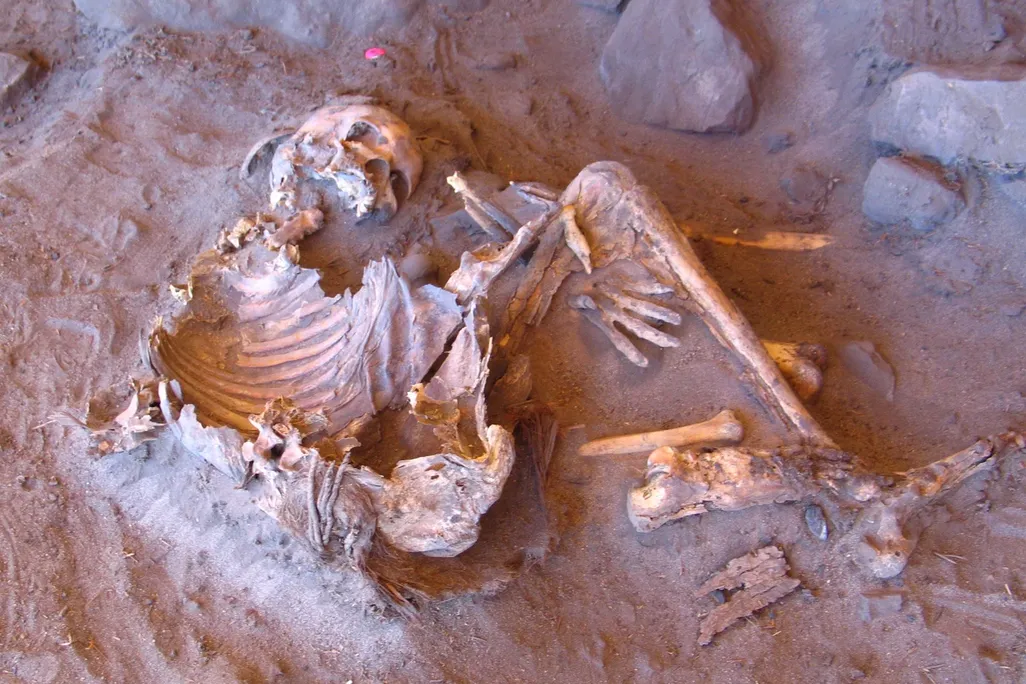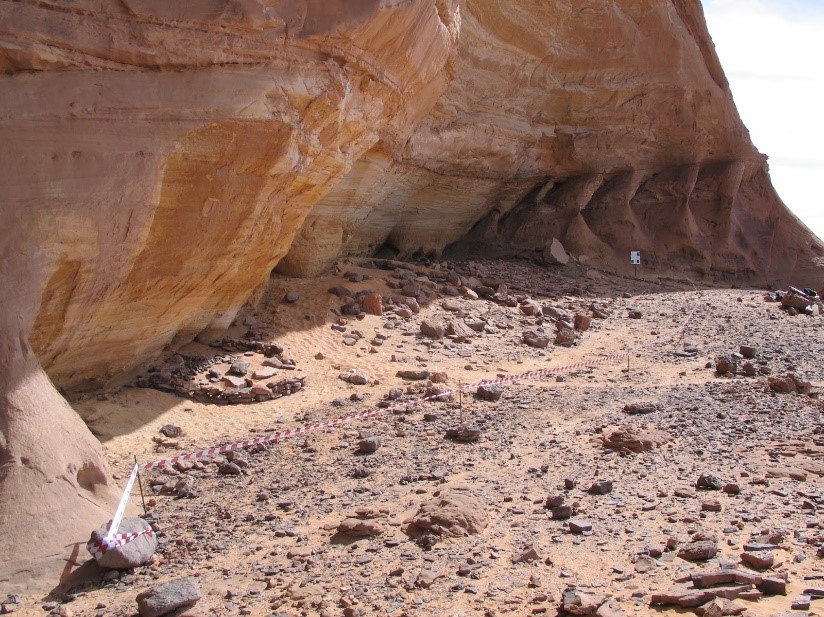
Archaeologists found 15 skeletons in a rock shelter in southwest Libya, including two naturally mummified women who died roughly 7,000 years ago. Archaeological Mission in the Sahara, Sapienza University of Rome
Between 5,000 and 14,000 years ago, the Sahara Desert looked nothing like it does today. It was lush and green, with lakes and rivers supporting a variety of animals—including humans.
But who were these ancient ancestors? And where do they fit on the human family tree?
Researchers think they finally have some answers to these questions. They’ve successfully analyzed the DNA of two naturally mummified livestock herders who died roughly 7,000 years ago in present-day Libya, which was part of what’s known as the “green Sahara.”
Their analyses revealed a previously unknown—and largely genetically distinct—population of ancient humans, according to a new paper published this month in the journal Nature.
The individuals who lived in the green Sahara showed “no significant genetic influence from sub-Saharan populations to the south or Near Eastern and prehistoric European groups to the north,” says study co-author Johannes Krause, a geneticist at Max Planck Institute for Evolutionary Anthropology, to Reuters’ Will Dunham.
“This suggests they remained genetically isolated despite practicing animal husbandry—a cultural innovation that originated outside Africa,” Krause adds.
That finding was unexpected, as researchers had long theorized the green Sahara was a human migration corridor between North Africa and sub-Saharan Africa. “It’s surprising,” says Eugenia D’Atanasio, a geneticist at the Sapienza University of Rome who was not involved with the research, to Science’s Andrew Curry. “I would have expected more gene flow across the green Sahara.”
Instead, the findings suggest that pastoralism—a nomadic lifestyle that involves herding livestock—spread across the green Sahara through “cultural exchange rather than large-scale migration,” says study co-author Nada Salem, a researcher at the Max Planck Institute for Evolutionary Anthropology, in a statement.
In the early 2000s, researchers discovered the remains of 15 ancient humans in southwest Libya near the border with Algeria. They found the skeletons in a rock shelter named Takarkori, along with pottery shards and rock art.
Archaeologists suspect the individuals buried at the site survived by hunting, fishing and herding animals like goats and sheep. Two of the skeletons were exceptionally well-preserved, with their skin, ligaments and tissues still intact, reports CNN’s Katie Hunt. Researchers determined they belonged to a pair of women in their 40s who had died around 5,000 B.C.E.
At first, researchers were only able to recover the women’s mitochondrial DNA, which gets passed down from mothers. But, eventually, they were able to sequence the mummies’ full genomes, which gave them a more complete understanding of their ancestry.
Their analyses revealed the green Sahara individuals likely branched off from the ancestors of sub-Saharan Africans roughly 50,000 years ago. Then, somehow, they remained genetically isolated for tens of thousands of years—a revelation that still perplexes researchers.
These individuals were “almost like living fossils,” Krause tells BBC Science Focus’ Tom Howarth.
“If you’d told me these genomes were 40,000 years old, I would have believed it,” he adds.
Scientists say they need to conduct more research to fully understand the individuals who lived in the green Sahara. DNA from two women may not be representative of all the humans who lived in this vast region over thousands of years.
Still, the paper makes a “key contribution” to scientists’ growing understanding of human ancestry, writes Mary Prendergast, an anthropologist at Rice University who was not involved with the research, in an accompanying commentary.
“Research is just beginning to reveal Africa’s complex population history, uncovering lineages barely detectable in the genomes of present-day people,” she writes. “In this context, even small sample numbers can shape our understanding of the past.”
The Takarkori individuals possessed genetic markers distinct from populations in sub-Saharan Africa, the team found, suggesting they were from a previously unknown and relatively isolated lineage that diverged from sub-Saharan African populations some 50,000 years ago. But the individuals did have some ancestors from the Levant, a stretch of land bordering the eastern Mediterranean Sea. The Takarkori DNA also showed traces of Neanderthal ancestry that could only have been acquired outside of Africa, as Neanderthals lived in Eurasia. But the mummies’ genomes contained 10 times less Neanderthal DNA than those of people living outside of Africa today.

Ancient human remains were found at the Takarkori rock shelter in southern Libya. (Image credit: View of the Takarkori rock shelter in Southern Libya.)
The findings suggest that the Green Sahara didn’t act as a migration corridor between sub-Saharan Africa and northern Africa. However, archaeological evidence suggests that cultural exchange between the regions did occur.
“We know now that they were isolated in terms of genetics, but not in cultural terms,” study co-author Savino di Lernia, an archaeologist at Sapienza University of Rome, told CNN. “There’s a lot of networks that we know from several parts of the continent, because we have pottery coming from sub-Saharan Africa. We have pottery coming from the Nile Valley and the like.”
The rise of pastoralism in the Sahara also likely arose from interactions with other groups that were raising domesticated animals at the time, rather than through large-scale migrations, the researchers suspected.
This isolated lineage no longer exists in its original form today, but at some point people from this lineage mingled with outsiders, which is why some people living in North Africa today have inherited pieces of this genetic heritage, the researchers found.
“By shedding light on the Sahara’s deep past, we aim to increase our knowledge of human migrations, adaptations, and cultural evolution in this key region,” di Lernia said in a statement.